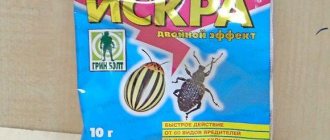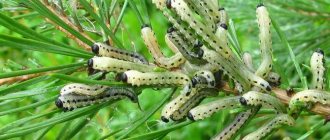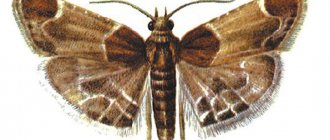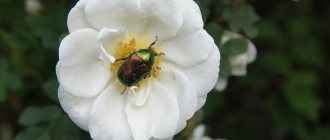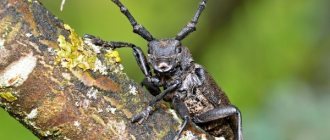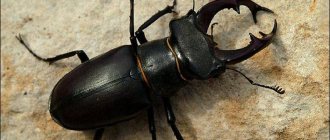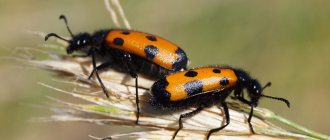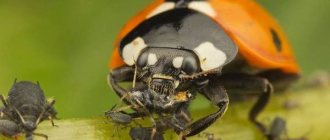Description of the weevil
Weevils vary in external characteristics and stages of development. Their larvae are thick, light-colored worms with a chitinous shell on their heads, usually C-shaped, whose body is covered with small hairs.
During their development, they are underground and eat the root system of plants; only some of their representatives live on the surface and feed on above-ground shoots. The larvae evolve into light-colored pupae, on which legs, wings, and a proboscis can already be distinguished. They then develop into adults.
The following groups of weevil beetles are distinguished:
- by the size of the nose (short-proboscis and long-proboscis);
- by color (yellow, brown, black, red, with or without a pattern on the shell);
- by body size (from 1 mm to 3 cm);
- according to body shape (rod-shaped, diamond-shaped, pear-shaped, spherical).
Dietary preferences
Several species of weevils are united under one name “pine” for a certain feature.
The weevil larvae are completely monovorous - they feed only on the roots of conifers.
They mainly attack weakened trees and settle in freshly cleared areas. But at the same time, adult individuals are polyphagous. Anything that grows near damaged conifers is at risk:
- oak;
- alder;
- birch;
- cherry;
- grape;
- apple.
Types of weevils
There are over 5,000 representatives of this type. The table shows the most common ones in gardens and vegetable gardens.
| View | Description | Plants susceptible to damage |
| Strawberry-raspberry | Height 3 mm. With gray hairs with grooves on the wings. The larvae are white. Appears with the growth of the first greenery. | Strawberries, raspberries, blackberries, strawberries. |
| Rice | Grows up to 3 mm. The most dangerous because it easily tolerates drought and happily feeds on dry plant species. | Cereals. |
| Beetroot | Length 15 mm. The abdomen is gray, the back is brown, the body is black, covered with small hairs. Lays white larvae that feed on plant roots. Thanks to its ability to burrow into the ground up to 60 cm deep, it easily tolerates severe frosts. | Beets, carrots, cabbage, cucumbers, legumes. |
| Southern gray | Up to 8 mm. Has a dark body. Has the ability to move great distances. Not picky, will not refuse a weed. | Sunflower, corn, winter crops. |
| fruit | The value is no more than 6 mm. Begins to become active during the period of bud formation, feasting on inflorescences and buds. It lays eggs in the fruits, making small depressions. | Fruit trees: peach, pear, cherry, apple, cherry, quince. |
| Barn | Up to 4 mm. Dark brown. It affects not only grains, but also products made from it. One egg laying can contain 300 eggs. | Cereals (wheat, oats, millet, rye, barley, etc.) |
Pine:
|
|
|
What do weevils look like and what do they eat?
Weevils are miniature beetles; the length of an adult individual, depending on the species, varies from 2 to 5 mm. The barn, rice, and acorn elephants most often enter the house. The morphology of these species has much in common, and only a specialist can distinguish them. The barn weevil is found more often than others in apartments.
We suggest you read: How to remove glue from glasses on glass, how to remove super glue from glasses lenses, how to wipe off marks: tips and tricks
Types of weevils
Juveniles are light brown in color; as they age, they become almost black. The body of the beetle is cylindrical with a characteristic elongated rostrum, for which it was nicknamed the elephant (see photo). The dimensions depend on the power components and reach 4-4.5 mm. The granary weevil's wings are poorly developed and cannot fly.
Interesting!
Weevils are very shy. They are afraid of light and illuminated places. Sensing danger, insects press their paws tightly to the floor and pretend to be dead.
Weevils in the kitchen infect cereals, pasta, flour, and corn grains. Some species feed on dried fruits, nuts, baked goods, tea and even herbal medicines. Both adults and larvae are harmful. In heated rooms at room temperature, beetles live for more than a year. The main determining factors for their development and reproduction are:
- temperature 10-25 °C;
- indoor humidity 65-70%;
- grain moisture content is 14-16%.
Review
I have been fighting weevils for several months now. For a long time I couldn’t understand why they started in flour and not in other products. And only after reading a number of articles, I determined that the reason lies in high humidity. I store flour in the pantry, and it is quite damp there.
Olga, Voronezh
How to get rid of weevils in open ground
All methods are good in resisting weevils - from biological to chemical.
If a pest is identified, action should be taken immediately.
Two solutions can help get rid of it on strawberries.
- The first is done like this: 1 teaspoon of iodine is dissolved in 10 liters of water.
- The second option is to dissolve 3 Intra-Vir tablets in a bucket of water.
Spraying is carried out 5-6 days before flowering, then in mid-summer.
On cherry trees, peeled bark should be torn off, and the cleaned areas should be treated with lime. Inspect for the presence of pests, or better yet, lay white material under the tree and shake it; if more than 10 individuals are detected, begin processing. Systematically remove fallen leaves and fruits.
On plums, resisting the beetle is the same as on cherries. Effective drugs: Bazudin, Fufanon, Actellik, containing pyrethrins and organic phosphorus compounds.
When an elephant is detected on raspberries, the same solutions are used as on strawberries. The most effective remedy will be Alatar.
To keep the nuts intact, you need to spray them with Fufanon or Actellik. Also of no small importance is digging up the soil near the tree trunk to a depth of 20-25 cm and cleaning this area from fallen leaves and unnecessary fruits.
Pine and spruce will be saved from parasites by drugs such as Karbofos, Actellik, Metaphos. Attracting their natural enemies (magpies, starlings, woodpeckers, rooks, crows, jays, ground beetles, and black beetles) will be an excellent solution to the problem.
How they live
Rice weevils are heat-loving insects; they live and reproduce at temperatures of 27-30 degrees, but do not die for 4 days if the frost drops to 5 degrees. In addition, they prefer air humidity of 70-90%, and grains - 10-17%.
These are marathon runners – agile and capable of covering long distances. They hide in a shaded place, and if the weevil is touched, it pretends to be dead, but not for long - it lies down and runs away.
“Rice farmers,” like marathon runners, have energetic breathing, so when they are poisoned by gas, they die faster than barn bugs.
Insects that overwinter in fields look for underground tunnels, burrows, or piles of grain for the winter. They live in one place until the food runs out, then they fly away or go to another nourishing place.
How to get rid of weevils in the house
A beetle may appear in an apartment due to the purchase of infected cereals. This type of beetle is called a barn beetle. You can escape from it by following a number of simple steps:
- Keep cereals in tight and well-closed containers. Place peeled garlic in containers with pasta and cereals, a couple of pieces of nutmeg with flour, and pepper with peas and beans.
- Warm the purchases in the oven at 60 degrees for 6 hours.
- Do not store food.
- Wipe storage shelves with soapy water and then with water and vinegar. Place lavender flowers, cloves, and bay leaves in the treated areas.
- Place purchased cereals, pasta, and flour in the freezer for a short period of time, or better yet, 2 days.
- View purchased products (tea, pasta, coffee, cocoa, cereals).
Prevention of occurrence
The basis of prevention is the inspection of purchased cereals to identify adult beetles, larvae or eggs. To avoid insects, it is recommended:
- clean containers from remnants of past cereals;
- keep storage boxes clean;
- grain collected at different periods should be stored separately;
- maintain humidity at 2-4%;
- refuse to store cereals in plastic bags;
- store cereals and pasta in hermetically sealed containers;
- regularly inspect inventory;
- Disinfect kitchen utensils in a timely manner.
To reduce the risk of weevils appearing in an apartment, it is recommended not to store cereals for longer than four months in a row. During the warmer months, supplies should be inspected every two weeks. In winter, the frequency of checking can be reduced.
When storing grains or pasta for a long time, containers with reserves should be placed in cool rooms where direct sunlight does not penetrate.
Folk remedies for weevils
There are several effective remedies, the preparation of which is not difficult:
- 150 g of chamomile is infused in a bucket of water for a day, then 50 g of soap is placed there.
- 400 g of dried crushed wormwood is poured with 10 liters of water and left for 24 hours. After the time has passed, 40 g of soap is added to the solution and everything is boiled for half an hour.
- Garlic and onion peels and pine tree branches are placed in a prepared container and filled with water; this mixture is left for several weeks. Then the mixture is cleaned (filtration) and mixed with water in a ratio of 1:10.
The affected area is treated every 5 days.
Preventive measures
To reduce the risk of weevils breeding in the home, it is recommended:
- When storing products, pre-process them;
- Pour cereals, pasta, dried fruits from plastic bags into containers with tight-fitting lids;
- Inspect products more often, in summer once every 14-15 days;
- Do not buy cereals “in reserve” and do not store them for 4 months;
- Do not leave food in the sun;
- Regularly do general cleaning and disinfection in the kitchen.
Simple measures and the ability to recognize the pest by appearance will protect household food supplies and preserve the health of the family.
The use of chemicals in the fight against weevils
This method is more effective than others, since fighting the parasite will take the least amount of time. The following drugs will help counteract it:
- Kinmiks (2.5 mg of product per 1 bucket of water);
- Detis (for 1 bucket of water – 2 mg of the drug);
- Fufanon, Iskra M, Kemifos, Karbafos-500 (per 1 liter of water - 1 mg);
- Fitoverm (per 1 liter of water – 2 mg);
- Karate (per 10 liters of water – 1 ml).
In order to lime the larvae of leaf species, Bazudin and Diazinon should be used. They resort to Karachar and Sensei before the flowering of the rocks.
They should be alternated so that the pest does not become accustomed.
The first spraying is carried out 5 days before flowering, the next after 9-11 days. This procedure is recommended to be carried out a couple of times during the period of crop development.
How do they reproduce?
Rice weevils are prolific insects. Under favorable conditions, 2-6 new generations of beetles appear in 12 months, because development takes 1-3 months.
To lay an egg, the female gnaws a hole in the grain and then seals it with the secreted substance. After 1-1.5 weeks, a larva emerges from the egg and gnaws out the passages inside. Sometimes eggs are laid on both sides of the grain, then 2 legless, white-yellow larvae live inside.
For 3-4 weeks the larva feeds on the internal contents of the grain, eating half of it, then pupates. During this time, the cereal becomes lighter by 30-70%. After 1-1.5 weeks, an adult beetle emerges from the cocoon, whose life lasts up to 6 months.
Mr. Summer resident advises: preventive measures
To prevent its occurrence, you can take a number of preventive actions, which are as follows:
- Clear the area of leaves and unnecessary branches in a timely manner.
- Cultivate the soil near the trees systematically.
- Plant repellent plants near growing crops, such as wormwood.
- Using lime, treat trees.
- Promote the appearance of birds that love beetles with the help of birdhouses, hanging them on trees.
- Periodically treat with a harmless special product, for example Fitoverm.
- Grow away from wild crops.
- In the spring, when the buds appear, the elephants should be shed, and hunting belts will become excellent helpers.
- Alternate sowing of crops.
A comprehensive and timely impact on the weevil will lead to the desired result: the beetle will be defeated.
What do rice weevils eat?
The beetle is called the “rice beetle” because it was first discovered by Carl Linnaeus in rice. In addition to this crop, the weevil loves:
- buckwheat,
- wheat,
- barley and other grains.
But it feeds only on damaged, wet and beaten grains. Does not refuse to nibble on dried fruits, baked goods and pasta.
In the first place among these pests are plants of the dicotyledonous class, and they feast on the green parts of the plant, flowers, fruits, and pollen, and prefer one type of plant.
Features of insect reproduction
Representatives of the rice weevil species are characterized by complete transformation. The female gnaws a hole in the grain and lays eggs in it. The fertility of one female is estimated at 300-500 embryos. After laying eggs, the beetle covers the hole with its secretions. Embryo development lasts from 6 to 12 days.
Rice weevil larvae
Newborn larvae are white in color without any pattern. The size of the young is 2.5-3 mm and their development continues in the grain. The larvae eat up all the nutrients and after 20-30 days, when they have gained the necessary mass, they enter the pupation stage. Initially, the pupae are white, but at the end of the phase they become yellow.
If weevils infest rice, the grain loses 30 to 70% of its original weight.
The adult lives no more than 6 months. The full development cycle ranges from 25 to 210 days. The determining factors for generation are humidity and temperature. If the temperature is below 12°C, the development of rice weevil embryos and larvae stops. From 2 to 4 generations develop per year.
What harm do weevils cause to indoor flowers?
- They lay their eggs in flower buds. The larvae are already beginning to eat the buds, so the plants never bloom.
- Adult insects gnaw off the leaves along the edges, leaving characteristic indentations. Also, round holes can be on the petals if the insect decides to feast on the edges of the petals.
- If the larvae get into the soil, they can eat roots and stems. If the damage is severe, the plant may die if nothing is done.
To exclude this, you need to carefully examine the leaves, remember when it last bloomed, etc. And through holes in the leaves, if there are any, already indicate that someone feasted on them. This is not typical for plant diseases.
Well, the most attentive and purposeful can take a magnifying glass and place the plant in a well-lit place to carefully examine it. There is a high probability that they will find that same weevil. If this bug does settle in the plant, you should get rid of it immediately, using different methods.
